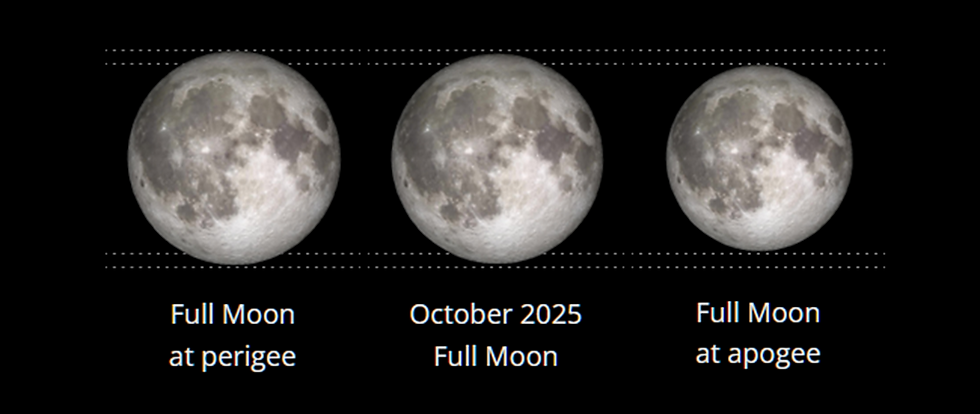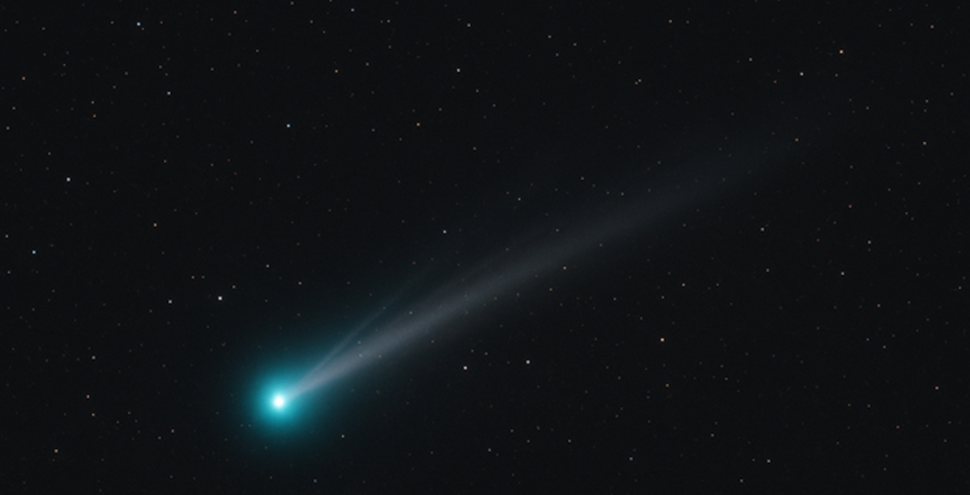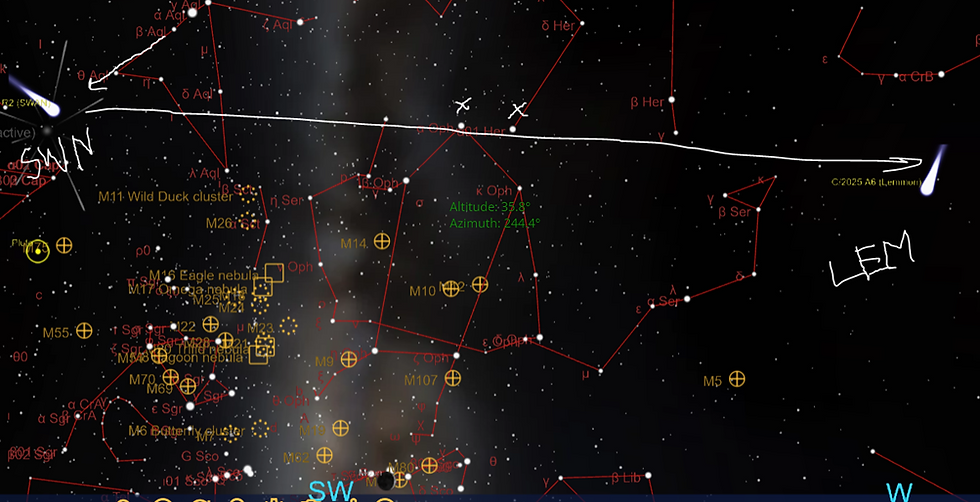What’s Up Above? October Stargazing
- astromarka
- Oct 4
- 10 min read
Outside my window and across the valley, there is a calico cat lounging on the ridge line of Angler Mountain. Asleep, the feline’s brilliant golds, chocolate browns, hints of rust, and tans, come together as patches of vibrancy spread out far and wide, weaved inside evergreen forests. The winds rise, and our cat’s fur shimmers in the mid-day sunlight. This mouser’s colors change by the day; and sometimes by the hour. Disappointingly soon, my tabby in its multicolored autumnal fur will awake and saunter off leaving stark skeletons of Aspens behind. That’s autumn in Colorado’s high country. If we’re lucky, the season of autumn lasts, oh, say about 2 days. Snow lurks just around the corner.
For us stargazers, October continues the transition between the summer night sky and the winter night sky. More so, this October is extra special because comets take center stage this month and a total of seven major and minor meteor showers rise to peak activity. That’s enough flares, streamers, bolides, fireballs, streakers, and smokers to light up the entire night the entire month. That’s beginning to end, start to finish, and every evening in-between.
Do me a favor right now; mark your calendar, and do it in all caps, the evening of October 24th and then gather your posse for some stargazing. That’s because the night of the 24th, is the night of comets! No kidding. I’m talking about you easily seeing 2 comets with your naked eye, on the same night. That’s right. From dusk till just a touch before midnight local time, you will see 2 naked-eye comets one in the southern and the other in the western sky. Pro tip: first, you don’t want to miss it and second bring your binoculars for even better views of our esteemed solar system visitors as they pass by.
Meteors and comets is what this month’s stargazing calendar is all about. The heck you say? Oh sure, the October Hunter’s Moon is a supermoon, and we can still view a few summer constellations to enjoy, despite the need to wear sweaters, coats, hats, and gloves.
But first, time to get your meteor shower bingo card out as start with the major and then the minor October meteor showers.
Draconid Meteor Shower, Peaking October 8th
Unlike the Orionids, you don’t have to get up after midnight and stay up all night to catch this show. Honestly, that’s the challenge of seeing most meteor showers at their optimal. It requires getting outside at ungodly hours of the night or in the extremely early morning hours of the new day. Not true for the Draconids which shower the night sky from October 6th through the 10th.
The Draconids are that rare meteor shower that is best observed between sunset and midnight. It’s because the constellation Draco, the dragon, from where the meteors appear to originate, is highest in the evening sky. The best time is soon after dusk. Get outside away from artificial light if you can, give yourself 20-minutes to get your night vision. Look to the northwest horizon, about 30 to 40 degrees above the horizon. That’s three to four widths of your fist on top of one another, thumb up, starting with your fist’s pinkie finger on the horizon. The Draconids are not predicted to be exceptional this year, around 5 – 10 per hour, but the angle at which the debris hits our atmosphere is conducive for longer streamer type shooting stars. Sadly, the Full Moon is only two days past and it will be an interfering factor diminishing your ability to see the faint meteoroids. Nonetheless, make a plan to get outside after sunset when the Draconids peak on their 8th and catch the dragon’s flames flashing across the night sky.
Orionids Meteor Shower, Peak October 21st
The Orionid meteor shower is an annual show for us in the northern hemisphere. The show runs from October 2nd through November 7th. This year the shower will peak on the nights of Oct. 21st and 22nd, with 15 – 20 meteors anticipated per hour between midnight and dawn. That’s not a bad rate. Interestingly, the Orionids meteor shower is a product of debris shed during the historic passes by Earth of the famous Halley’s Comet. Want to see the Orionids? Find a nice dark-sky location and then around 10:25pm local time the constellation Orion will rise over the eastern horizon. Settle in, recline your chair backwards, and look straight up to the zenith of the night sky; that point directly overhead. There’s no rush to get outside if you just want to view the meteor shower since they really don’t fully start to streak until after midnight. A warm drink of whatever you fancy will be a good companion at that hour. Try to keep a wide angle view of the sky above you as meteors can come from any direction.
Now, the minor October meteor showers:
Camelopardalid Meteor Shower, Peaking October 5th
One big thing that makes the Camelopardalid meteor shower special every year is they are up all night. That’s right, the radiant point for the shower never sets over the horizon since it is a circumpolar meteor shower. Meaning, it circles the North Pole Star all night, every night the shower is active, which is unfortunately brief. The Camelopardalid is active from October 5th through October 6th. The meteor shower peaks on the 5th and its radiant point is in the constellation Draco, the dragon. This show is expected to display the most meteors shortly before dawn on the 6th due to the Earth's position as it passes through the debris field. Most unfortunate is this shower happens the night before the Full Moon. Despite this shower occurring on the opposite side of the sky from the Full Moon, its light will be annoying and block out many of the faint meteoroids. Under ideal dark sky conditions, you can anticipate seeing about 2 -4 meteoroids per hour.
Southern Taurid Meteor Shower, Peaking October 10th
The Southern Taurid meteor shower is active from September 10th to November 20th, and expected to peak around October 10th. On that date the radiant point (that area in the sky where many of the meteors originate) lies inside the constellation Cetus, the sea monster. Cetus rises above the eastern horizon after 8:30pm local time and remains active throughout the night. Historically, the Southern Taurid averages about 5 meteoroids per hour. Due to the slower speed of the meteors, those that hit the upper reaches of our atmosphere are more often fireballs, and are easier to notice and quite stunning.
Delta Aurigid Meteor Shower, Peaking October 11th
The δ-Aurigid meteor shower will be active from October 10th through October 18th with peak rate anticipated to be on the 11th of this month. On that date, under dark conditions, 2 meteors per hour are anticipated. The shower’s radiant point is inside the constellation Auriga, the Charioteer. The shower’s radiant point will rise above the north-northeastern horizon at 9:30pm local time remaining above the horizon circling the Northern Pole Star, Polaris till it is washed out by the breaking dawn of October 12th around 6:30am. As this shower is a circumpolar meteor shower, the direct interference of moonlight is lessened. Still, this year the Full Moon’s luminescence will interfere and wash out some comets. The best time to view this show is around 5am on the 12th. Custom made for our early risers.
Epsilon-Geminid Meteor Shower, Peaking October 18th
The ε-Geminids are active from October 14th through October 27th with the peak rate of meteoroids expected to be on the 18th. The expected number of meteoroids per hour is low. Typically this shower displays 2 meteoroids per hour under the most ideal conditions. Sadly, as the Moon is close to being full, its luminescence will make seeing even the brightest meteors difficult. The shower rises inside the constellation Gemini, the twins, after 10pm local time over the northeast horizon. The radiant point culminates just before dawn on the 19th and is likely to produce its best displays at that time.
Leonis Minorid Meteor Shower, Peaking October 24th
The Leonis Minorid meteor shower will be active from October 19th through October 27th. The shower peaks on October 24th. This shower, like most minor meteor showers, offers fewer meteoroids to view. Under ideal dark conditions, which is the case this year, the Leonis produce an average of 2 per hour. The parent body (comet) responsible for creating the Leonis Minorid shower has been identified as comet C/1739 K1. This shower’s advantage is it occurs two days after the New Moon so the skies will be darker making it much easier for you to pick up faint meteors. Look to the northeast after midnight on the 23rd, and as the constellation Leo Minor, rises over the horizon. Look for the Big Dipper asterism and the radiant point for this shower is a touch below its handle, or ladle. You’ll have all night to view the shower before the breaking new day washes out the shower, around 6:45am local time.
A Super Hunter Supermoon, October 6th

This month’s Full Hunter’s Moon occurs at 9:47pm local time this October, and it is also a supermoon. This month’s supermoon is at 224,313 miles away from Earth and is at perigee in its orbit around the Earth. The average Earth/Moon separation distance is between 252,711 and 221,518 miles. Take another look at the image above to see the difference. Take heed, if you are a Mariner, you can expect high tide to be higher than normal. It may be surprising to learn that many, many Indigenous peoples around the world kept track of the seasons through their assignment of unique names and meanings for each month’s Full Moon. Each name is associated with the focus of living and survival during that month. October’s Hunter Moon denotes the time when tribes, mainly in North America, hunted and gathered meat and berries for the long winter season ahead. Similar in reason as to why the September Full Moon is called the Harvest Moon.
A Comet to Behold with Your Own Eyes. C/2025 A6 Lemmon, October 21st

“Comets make me happy.” When my astronomy mentor told me this for the first time, it came as a surprise. Prior to her declaration, thinking of happiness as the emotion comets manifest didn’t enter my spirit. Now, that’s changed. This October, on the 21st is your moment to experience “comet induced happiness.”
The name of a comet is determined by a set of rules from the International Astronomical Union. Let’s break the name apart.
The “C/” refers to a non-periodic comet. This means the comet hasn’t been observed before, and its orbital period (the amount of time it takes to complete one orbit around the Sun) is greater than 200 years. Next, the “2025” denotes the year the comet was discovered. Then the “A” indicates the half-month it was discovered. This can get tricky so a bit of explanation will help. For comet nomenclature, the first half of January is “A,” the second half of January is “B,” the first half of February is “C,” and the second half of February is “D”, and so on, for the remainder of the calendar year. With the “6” indicating that this comet was the sixth comet discovered in the first half of January. It is estimated that the orbital period for C/2023 A3 is thought to be 1,350 years. Lastly, “Lemmon” in the comet’s name references the Mount Lemmon Survey telescope located in the Santa Catalina Mountains north east of Tucson, Arizona. The telescope first imaged the comet on January 3rd of this year.
For you to find happiness on the 21st, here’s what you need to do. To begin, comet Lemmon will be at perigee. Meaning, it is the closest it will get to the Earth in its orbit at that time making it clearly visible to the naked-eye shining at a magnitude of 3.4. (Recall that any magnitude, that is a natural number of 6 or less, you can see without the aid of optics.) Get outside and look towards the western horizon after 7pm local time. Extend your arm, close your fist, turn your thumb up, and look two fist’s width above the horizon for a fuzzy patch with a tail. After sunset at 7:20pm, you have approximately 3-hours to view the comet before it slides below the western horizon.
Of course, observing conditions (clouds, light pollution, phase of the Moon) will impact your view. Fortunately, the 21st is a New Moon so our solar system’s street light will be dark that night. If everything lines up, the image above is a close approximation for what you’ll see. Make sure you have your binoculars ready to view the comet’s subtle ion tail along with its debris tail. If you happen to miss comet Lemmon on the 21st, don’t despair; you’ll have a day or two before the crescent Moon rises in the west diminishing your view of the comet. Even then, you’ll still be able to see our cosmic messenger.
A Pre-Halloween Treat. No Trick, Two Comets, One Night, October 24th

Okay, I know the above image is busy and initially, gibberish, so let me decipher it for you.
But first, what would the month of October be without a reference to Halloween? It just wouldn’t be kosher. This year how about we skip the trick and have an extremely rare treat instead? I’m talking about the type of treats that won’t someday require a trip to your dentist. What is the treat? How about two sugar-free comets to enjoy with your naked eye.
Now, back to the above image. It depicts a panoramic view of the southern to the western sky from the horizon up to approximately 60 degrees. The two visible comets are C/2025 R2 Swan on the left, and comet C/2025 A6 Lemmon on the right shown at 7:30pm local time.
Once you get outside, face south. Extend your arm straight out, close your fist and turn your thumb up. Approximately 6 fists placed on top of one another up from the horizon you’ll find three stars in a diagonal row, with a middle star the brightest of the three. Those stars create an eagle’s beak and a lightning bolt it holds, all of which are part of the constellation Aquila, the Eagle. Continue the diagonal of the stars down back towards the horizon, and after going twice the length of the three stars there you’ll see comet Swan at magnitude 4.
To find comet Lemmon, draw an imaginary line straight west from comet Swan, parallel to the horizon passing underneath two similar magnitude stars close to one another above the imaginary line you continue to draw heading west. The stars are marked with “X”s on the image above. Finally, continue your imaginary line west the same distance you travelled from comet Swan to the pair of bright stars. The two stars are the mid-point of your imaginary line. At the end of your line segment is comet Lemmon. Clearly visible at a magnitude 3 with a distinct fuzzy coma and tail. As the New Moon was just three days prior, moonlight shouldn’t interfere with you finding and enjoying our galactic guests. Your window to view the pair is about three hours before comet Lemmon sets in the west-northwest. It will certainly be a sight to behold. Are you happy?
Unquestionably, the October stargazing calendar is full. It’s no stretch to say that there are big things happening in the night sky every night this month. From seemingly back-to-back continuous meteor showers, to comets galore, a supermoon Full Harvest Moon, and wrapping up the month with a Halloween double treat of two naked eye comets! It was foretold that October would have multiple celestial joys and wonders for us to harvest. It’s nice when our expectations are met. And that ain’t no boo!
Oh, and as for that calico cat sleeping on top of Angler Mountain, she’s moved on. Snow is expected this weekend.
Clear skies to you and enjoy the meteor showers and the comets too!






Comments